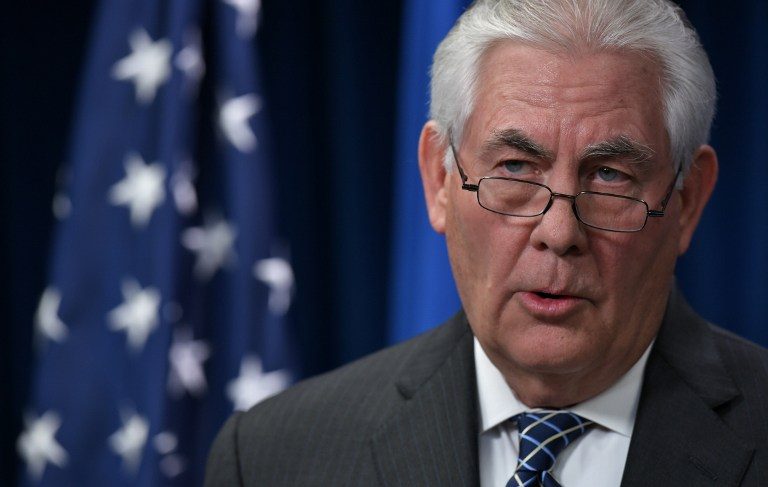SUMMARY
This is AI generated summarization, which may have errors. For context, always refer to the full article.

TOKYO, Japan (UPDATED) – Washington’s top diplomat arrived in the Demilitarized Zone dividing the two Koreas to gaze on the North for himself Friday, March 17, a day after he declared 20 years of efforts to denuclearize it had failed.
Secretary of State Rex Tillerson is in Asia for his first foray into crisis management, and was to hold talks with South Korea’s acting president Hwang Kyo-Ahn later, after China challenged him to come up with a new way to confront the North Korean nuclear stand-off.
Tillerson landed at Osan air base in South Korea from Japan and transferred to a Blackhawk helicopter for his trip to the DMZ, where he met the commander of the 28,000 US troops stationed in the South to defend the country.
He vowed in Tokyo on Thursday, March 16, to press Beijing to rein in its neighbor but, speaking after meeting Japanese officials, offered no new details of his plan to defuse the threat posed by Pyongyang’s recent ballistic missile tests.
He warned that past policies and punishments have had virtually no effect on Pyongyang’s ambitions and that a new course was needed.
“I think it’s important to recognize that the diplomatic and other efforts of the past 20 years to bring North Korea to a point of denuclearization have failed,” he said.
On Saturday, March 18, Tillerson will head to China to press the North’s key diplomatic protector and trade partner to back tougher sanctions – but Beijing has been infuriated by the deployment of a US missile defense system to the South.
North Korea has a long-standing ambition to become a nuclear power and conducted its first underground atomic test in 2006, in the teeth of global opposition.
Four more test blasts have followed, two of them last year.
It has continued to defy the international community, even after two rounds of UN-backed sanctions, and last week test fired a salvo of missiles that fell in waters off Japan.
‘Unwavering commitment’
“In the face of the ever-escalating threat it is clear that a new approach is required,” Tillerson said.
And he reiterated Washington’s vow to back key regional allies Japan and South Korea in the event of attack.
“The US commitment to the defense of Japan and its other treaty allies through the full range of our military capabilities is unwavering,” he promised.
US President Donald Trump stirred concern in the region during his White House campaign by suggesting allies like Japan and South Korea need to do more to defend themselves.
But since his victory he has twice met with Japanese Prime Minister Shinzo Abe and has been careful to offer complete support, as Tillerson reiterated.
US officials have been spooked by North Korea’s accelerating progress towards building an intercontinental ballistic missile that could threaten US mainland cities.
But China is perhaps the last country with significant leverage over Kim Jong-Un’s isolated regime.
“We do believe they have a very important role to play,” Tillerson said. “We will be having discussions with China as to other actions that they should be undertaking.”
Beijing shares US concerns over Pyongyang’s attempts to build an arsenal of nuclear devices, but has also blamed Washington for escalating tensions.
The issue is made more complicated by the deployment of the US Terminal High Altitude Area Defense (THAAD) anti-missile system to South Korea.
Washington and Seoul say it is for purely defensive purposes, but Beijing fears it could undermine its own nuclear deterrent and has reacted with fury, imposing a series of measures seen as economic retaliation in the South.
Chinese foreign ministry spokeswoman Hua Chunying said at a briefing Thursday that Beijing stood by its call for a halt to joint US-South Korean exercises, to lower tensions.
“If the US or another country has a better plan, a better proposal, they can bring it out,” she said.
In the absence of specific details on how to increase pressure on Pyongyang from either Tillerson or his Japanese host, observers see a range of stark options.
They include a pre-emptive strike against missile and nuclear facilities or stepped up sanctions.
But the United States could also open a dialogue with the North – something it has currently made conditional on a tangible commitment by Pyongyang to stop the programs. – Rappler.com
Add a comment
How does this make you feel?
There are no comments yet. Add your comment to start the conversation.